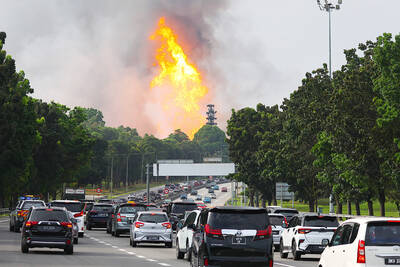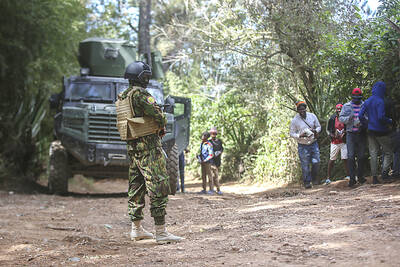This week's discovery of mad cow disease in the US presents the biggest challenge to consumer confidence in the food supply since a crisis three years ago when biotech corn not approved for human consumption showed up in hundreds of supermarket products.
A cow slaughtered on Dec. 9 in a tiny town in Washington state has tested positive for mad cow disease, sending shock waves through the US$27 billion US cattle industry and shutting down American beef sales to major foreign buyers.
American ranchers, beef packers and food retailers are awaiting final lab results on tissue from the four-year-old Holstein dairy cow in coming days.
In the meantime federal investigators were scouring records to chart the life of the animal and others in its birth herd for evidence that they may have consumed contaminated feed.
Mad cow disease, or bovine spongiform encephalopathy (BSE), is a brain-wasting disease thought to be transmitted from animal feed containing bovine brains or spinal cord. The US bans the use of those materials in feed.
But some consumer groups argue that illegal feed might not be the only culprit, warning that as carcasses are processed, high-risk material could accidentally contaminate the beef.
The first known US case of mad cow disease has prompted those groups to call for tighter beef industry regulations.
Scientists believe people can contract a human variant of mad cow disease by eating beef products infected by BSE. An outbreak of mad cow disease in Europe over a decade ago, when few protections were in place, resulted in 137 human deaths so far.
US Agriculture Secretary Ann Veneman, in announcing the Washington state mad cow case on Tuesday, insisted American beef remained safe. She has noted a lone case of BSE in Canada last spring did not dampen beef consumption in North America.
But investors fear consumers could reverse a beef-eating binge fueled in part by popular high-protein diets.
In trading on Wednesday, fast-food hamburger restaurants like McDonald's, Burger King and Wendy's saw stock prices drop and cattle futures fell by the limit allowed by the exchange.
In 2000, vast amounts of taco shells and more than 300 other corn-based products were whisked off market shelves after a genetically modified corn variety, StarLink, was found in the food supply. The product, approved only for animal feed, dealt a severe blow to US-Japan food trade.
The coming days and weeks will test American consumers' response to the mad cow case.
Andy Hemmendinger, 45, who lives in a suburb of Washington, said he would now "probably wait a little bit" before buying beef in a restaurant, "just to see what they find."
He added that the beef he eats at home two or three times a week is usually organically grown and said he wanted to know more about the transmission of mad cow disease.
"You're always torn between over-reacting because one thing happens and being foolish for not finding out what you can and making a good decision," he said.
Trading partners immediately closed their borders.
Japan, South Korea and Mexico, the three top buyers of the US$3 billion worth of beef the US exports annually, quickly suspended American beef imports. China, a potentially huge market for US beef, followed on Thursday.
But the Bush administration and US industry want to move away from the long-term trade bans prompted by the EU epidemic, if countries that experience isolated cases of mad cow disease have strong programs in place to prevent the disease's spread.
Chandler Keys, vice president of the National Cattlemen's Beef Association, told reporters on Wednesday, "I think it's time for all of us to sit down and say enough's enough on this irrational behavior. We need to come back to sound science."
Also See Story:
Japan bans all US beef products

A fire caused by a burst gas pipe yesterday spread to several homes and sent a fireball soaring into the sky outside Malaysia’s largest city, injuring more than 100 people. The towering inferno near a gas station in Putra Heights outside Kuala Lumpur was visible for kilometers and lasted for several hours. It happened during a public holiday as Muslims, who are the majority in Malaysia, celebrate the second day of Eid al-Fitr. National oil company Petronas said the fire started at one of its gas pipelines at 8:10am and the affected pipeline was later isolated. Disaster management officials said shutting the

DITCH TACTICS: Kenyan officers were on their way to rescue Haitian police stuck in a ditch suspected to have been deliberately dug by Haitian gang members A Kenyan policeman deployed in Haiti has gone missing after violent gangs attacked a group of officers on a rescue mission, a UN-backed multinational security mission said in a statement yesterday. The Kenyan officers on Tuesday were on their way to rescue Haitian police stuck in a ditch “suspected to have been deliberately dug by gangs,” the statement said, adding that “specialized teams have been deployed” to search for the missing officer. Local media outlets in Haiti reported that the officer had been killed and videos of a lifeless man clothed in Kenyan uniform were shared on social media. Gang violence has left

US Vice President J.D. Vance on Friday accused Denmark of not having done enough to protect Greenland, when he visited the strategically placed and resource-rich Danish territory coveted by US President Donald Trump. Vance made his comment during a trip to the Pituffik Space Base in northwestern Greenland, a visit viewed by Copenhagen and Nuuk as a provocation. “Our message to Denmark is very simple: You have not done a good job by the people of Greenland,” Vance told a news conference. “You have under-invested in the people of Greenland, and you have under-invested in the security architecture of this

Japan unveiled a plan on Thursday to evacuate around 120,000 residents and tourists from its southern islets near Taiwan within six days in the event of an “emergency”. The plan was put together as “the security situation surrounding our nation grows severe” and with an “emergency” in mind, the government’s crisis management office said. Exactly what that emergency might be was left unspecified in the plan but it envisages the evacuation of around 120,000 people in five Japanese islets close to Taiwan. China claims Taiwan as part of its territory and has stepped up military pressure in recent years, including